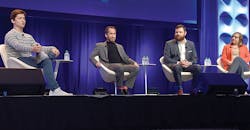FABTECH panelists ponder challenges, opportunities associated with younger employees in manufacturing
While many employers still are trying to master millennials, FABTECH is preparing manufacturers for Gen Z, derogatorily deemed the Tide Pod generation, whose oldest members are in their early 20s.
While this clearly is a misnomer—as Jacob Wilson, CEO of Morrison Industries points out, everyone did “silly things” when they were young, they just didn’t put them on the internet—it taps into the differences in a generation raised on devices, social media, YouTube how-to videos and memes.
But David Stillman, co-author of Gen Z @ Work, says they have more in common with baby boomers than their Gen X parents.
“A lot of boomers are saying ‘It reminds me of me. I was so competitive,’” said Stillman, a Gen Xer. “‘I remember working hard, trying to get ahead,’ so there are a lot of baby boomers saying it’s great to see this competitive side back. So I’m not worried about the baby boomer-Gen Z mentality.
“I’d say, baby boomers, make yourselves accessible to Gen Z. They want to learn.”
Wilson and Stillman were part of a “New Generation Workforce” panel at FABTECH 2018 in November in Atlanta, Georgia, that included Jonah Stillman, a Gen Z ambassador who co-authored Gen Z @ Work with his dad, David Stillman, and Lee Ann Cochran, PRADCO’s vice president of sales and marketing.
They touched on multiple Generation Z topics, including how to spark their interest in manufacturing, ways to keep them engaged, advantages and disadvantages of employing Gen Zers for small businesses, preferred methods of communication, and Gen Z trends and expectations.
Here are some selected highlights, with questions and answers edited for space and clarity:
Issue: Whether it’s a lack of interest, awareness, social acceptance or elsewise, many Gen Zers aren’t looking into manufacturing careers. What needs to happen to put the industry on the map?
With so much forward-thinking tech in manufacturing today, Cochran sees plenty of opportunity here.
“What organizations can do is start bringing manufacturing to Gen Z,” Cochran said. “What I mean by that is doing it in a digital way, with videos, hosting tours at their facility, and getting people out there to talk about what they do on their jobs, and make them exciting, because there are so many interesting positions.”
Wilson said manufacturers can better market themselves, including using social media like Facebook, which he’s utilized to attract candidates who didn’t know his company existed previously.
“Use all the digital platforms that Gen Z already is engaged with to advertise,” he said. “Standard operating procedure for HR is to put an ad in the classifieds in the newspaper, but Gen Z is not reading the newspaper.”
Along the lines of better marketing, David Stillman suggests painting a complete picture of what the job entails, making it come alive for Gen Zers looking for more than a dry work description.
“If they can picture it, they can picture themselves doing the job,” he said.
Issue: What does it take to keep Gen Zers engaged after they’re hired?
Wilson says to show Gen Zers the path to success.
Start mentoring early, teach them what they need to know, and why, connect them to their peers and managers, and don’t stick them in an entry-level position and expect them to advance on their own.
Also, make sure to understand what engagement means to them.
“Engagement might mean, for a new Gen Zer, to be out there teaching someone else what they’ve learned already, so they can really master that trade in a different fashion,” Cochran said. “Engagement might mean they have time to work on side projects that are a little bit different, in an introverted way, not even an extroverted way. And engagement could mean they’re looking to interact with their supervisors, and their supervisors’ supervisors, to understand what the future looks like.”
Tell them the company’s story, Wilson says, as part of the onboarding process.
“Make sure they know where the company is headed, what the purpose of the business is, and what your values are,” he said.
Other suggestions involve providing variety in job duties and scheduling.
Issue: What are the advantages and disadvantages of hiring Gen Zers for small to medium business (SMBs)?
Gen Zers are versatile and capable of wearing multiple hats, Cochran said, enabling innovative businesses to deploy them in non-traditional ways, across company divisions with different responsibilities.
Wilson sees an advantage in relationship building, with the right approach.
“We’re still in a place where I’m able to build a relationship with every employee on our team, and my whole management team is able to do that,” he said. “When you can take the time to sit down and have lunch with a Gen Z who comes in off the street, and doesn’t know anything about your company, then you have an opportunity to have them on your team for the next 25 to 30 years.”
One disadvantage is a tendency for SMBs to lean on ad hoc training methods and instructors who pass on bad habits and risky shortcuts, so David Stillman suggests looking into resources for training Gen Zers.
Issue: How do differing generational work styles mesh in business?
Millennials often are Gen Zers’ frontline managers, so their interactions are vitally important to a company’s success.
Wilson, a millennial, had to adjust his preconceptions of managers as gruff, no-nonsense dictators who order people around and pound their desks when minions mess up or, even worse, voice opinions.
“That doesn’t really work well, and it’s not in my nature anyway,” Wilson said.
“From what I’ve seen so far, if you can just be vulnerable and open with the younger generations, they’ll get on your team a lot faster.”
Wilson said he views employees more like customers, because quality team members are a valuable resource.
Cochran said it’s important to identify what form of communication works best, be it email, phone call, text or face-to-face meeting. Don’t assume Gen Zers prefer texting, and don’t discount digital discussions.
David Stillman’s advice for Gen Z team members: “Think evolution, not revolution.”
Issue: What’s the biggest industry trend that won’t work?
Wilson identified the use of staffing companies and temp services as outdated ways to find workers. Gen Zers aren’t interested in going through the motions, and being a number on a piece of paper, he said, so his company decided to skip the third-party recruiters and go straight to direct hiring.
“It’s allowed us to overcome that perpetual turnover machine,” he said.
Cochran doesn’t see Gen Zers spending their careers in one market, making it harder to pass on industry knowledge.
“They’re going to want change, they’re going to want to figure out how to solve different problems across marketplaces,” she said. “So it’s going to be important for us to think about how that industry knowledge is shared, how associations and societies are grown, and make sure data is accessible.”
David Stillman says “that’s the way it’s always been done” won’t work for Gen Zers, so employers should explain why it’s done a certain way and be prepared for their input, whether they’ve been on board for two years or two days.
“Just because it’s not broke, in their eyes that doesn’t mean it can’t get better,” he said.
Issue: What aspects of the Gen Z workforce are most and least exciting?
First and foremost, Gen Zers get technology, and that’s a good thing.
“I’m really excited about that because technology is changing the face of manufacturing, it is evolving it and a very positive way, and Gen Z can help lead the way,” said Cochran, who also frets over the “healthy” tension that comes with older generations’ attempts to modify habits in changing times.
Wilson worries about keeping the next generation engaged, especially in the more laborious fabrication jobs, like welding, but he’s optimistic about the potential of a generation raised in a connected society.
“This is a generation that has had the knowledge of the entire world at their fingertips for their entire lives, and they are really good at harnessing that, and they’re incredibly resourceful in taking that knowledge and applying it,” he said. “The idea that they don’t know how to do something is foreign to them.
“They think they can watch a YouTube video and figure out how to do it really quickly.”
About the Author
Jason McDaniel
Jason McDaniel, based in the Houston TX area, has nearly 20 years of experience as a journalist. He spent 15 writing and editing for daily newspapers, including the Houston Chronicle, and began covering the commercial vehicle industry in 2018. He was named editor of Bulk Transporter and Refrigerated Transporter magazines in July 2020.


